![]()
- 5th Annual Scuba Skills Recap
- Easter Island Statues in Deerfield Beach
- John U. Lloyd Park History
- Miami’s Maritime Heritage Underwater Trail
- PSI vs Bar
- Diving the Erojacks
- ADA’s Partnership with Coral Restoration Foundation
- Out of Air, What To Do!?
- Why Dives Get Cancelled
- BCD Leaking?
- Newsletter Delivery Options
- Email or Address Change?
- T-Shirts For Sale
- ADA Guidelines and Policies
The 5th Annual ADA Scuba Skills Tune-Up Event Recap
--by Lon Von Lintel and Rachel Davis

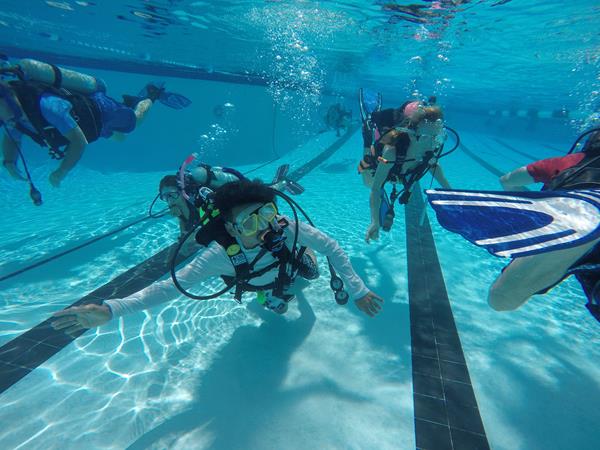
ADA would like to welcome our newest members who joined at the event: Vicky Marsh, Stefano Barbosa, Thomas Rodrigues, Osman Murillio and Rick Klein. ADA also welcomed participation in the event by current members Maureen Curtin, Bill Curtin, and John Davis.
If you missed this year's event, make plans to join us next year in May 2017 for our 6th Annual Scuba Skills Tune-Up. Stay tuned to the eNews and our monthly newsletter to stay informed about upcoming ADA events.
![]()
Easter Island Statues in Deerfield Beach
--by Jerry Kosakowski
Before we begin, did you hear that Deerfield was voted as one of the most enjoyable places to live in America? Have you been there lately? It is beautiful and they did wonders with the transformation. It was run-down and shabby. I recall going there often when I was working and it wasn’t the best by a wide margin. I drove through this spring, and the area was really nice, tidy and clean.
 Rapa Nui, so named by
the indigenous people who lived there, is a remote
island off the coast of Chile. The Dutch explorer Jacob
Roggeveen named it Easter Island when he "discovered" it
on Easter Sunday, April 5, 1722. The original statues,
called moai, were erected on the island of Rapa Nui
between the years 1259 and 1500 C.E. There are 887
statues on Easter Island, the tallest being 33 feet high
and weighing 82 tons.
Rapa Nui, so named by
the indigenous people who lived there, is a remote
island off the coast of Chile. The Dutch explorer Jacob
Roggeveen named it Easter Island when he "discovered" it
on Easter Sunday, April 5, 1722. The original statues,
called moai, were erected on the island of Rapa Nui
between the years 1259 and 1500 C.E. There are 887
statues on Easter Island, the tallest being 33 feet high
and weighing 82 tons.
Ok, those Easter Island-inspired statues were going to be an underwater dive site.
Artist Dennis MacDonald created the sculptures from approximately 600.000 pounds of concrete. There were 15 statutes in all, cast from concrete, and ranging from 8 to 22 feet tall. It was going to make a big splash. It did make a splash, but not the way intended.
They were all loaded on the barge being ready to be placed. It was June 7, 2015 and everything was a go.... up until the barge was tipped from waves. The barge, along with all the statues, promptly tumbled into the 70 feet water. Barge and all were a total wreck. Well, can we can dive it as a real wreck? Yes? No? No! It can’t be dived due to the unstable condition of the barge and jagged, sharp exposed edges. It is now a mix of twisted steel and concrete. Not quite the attraction that was planned.
But in good American spir,t MacDonald states he will rebuild. I hope so. South Florida seems big on dreams for the Ocean and short on accomplishments. Recall the Christopher Columbus statue that was going to be as big as the Statue of Liberty and placed at the entrance to Miami Beach? Another failed dream. I hope this one ultimately comes through.
To view a video of the sinking barge, Click here.
![]()
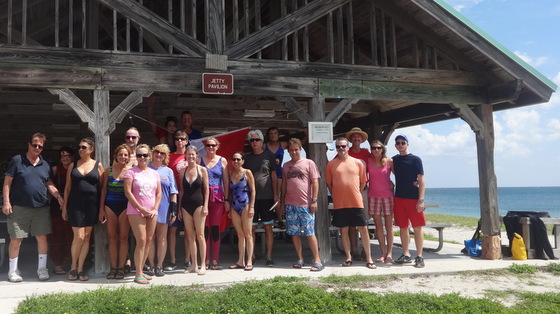
Are you aware that John Lloyd Park has a vast history? Did you know that the park was part of the original barefoot mailman route that covered 68 miles. Not exactly what the normal mailman does today. Ever notice the barefoot mailman monument along A1A in Hillsboro? Keep your eyes peeled. It’s a Florida Landmark. Actually, there were several mailmen doing the route and collectively they became known as the barefoot mailman.
Yes, they had to swim the channels and with those currents that was no easy feat in stormy weather. Heck, just dive near the channel and you note the pickup in the current. You better be in your best shape, for the current is heavy. Sometimes I have to resort to holding o to one rock at a time, just to escape it. But then, I don’t have to walk that 68 mile route. That would get you into shape.
The history is also filled with racial strife. African-Americans loved this beach and some drove from as far as West Palm Beach to swim here. In 1946, a petition was made “seeking a public bathing beach for the colored people in Broward County" by the Negro Professional and Business Men’s League. Yes, it was that bad. Racial strife continued and the park was part of that focus. Finally, in 1954 the State of Florida acquired the site and designated it for segregation and promised to have the beach accessible, but in the usual government fashion, failed to build a road to it.
Finally with efforts by John U Lloyd, Broward State Attorney, the county purchased the land in 1954 and named the park after him. In 1973 the State purchased the land from the county, which consisted of 117 acres, for approximately $15,000,000.00. Over time, it was expanded and is now 310 acres of some of the finest beaches in Florida. It is my favorit,e and I always purchase the annual state park pass (good for all state parks) because I get my money’s worth just with this park. Everytime I take the grandkids to the beach they know where Grandpa is going. No complaints though, because they always enjoy themselves there as well.
The park has been awarded the "Top Parks of Florida" award and it gets my vote also.
--Information Obtained From https://www.floridastateparks.org/park-history/Lloyd-Beach
Photos: U.S. National Park Service
Biscayne National Park’s Maritime Heritage Trail explores six wrecks, spanning nearly a century. Most divers from South Florida have dove on these sites, but probably not all together while following an underwater trail. Learn more about the Trail at www.nps.gov.

Each site has been mapped, brochures have been produced and mooring buoys have been installed. Each wreck is marked with a bronze underwater plaque. Learn about each wreck and its history by printing out the brochures. Exact coordinates for locations are given along with a rendering of the wreck.
Access to these sites is by boat only. Three sites (Erl King, Alicia, and, Lugano) are best suited to SCUBA divers, while the other sites can easily be enjoyed while snorkeling.
Leave from Key Biscayne and head to the most northern site, Fowey Rocks Lighthouse. Technically not a wreck, the Fowey Rocks Lighthouse was built in 1878, on the outer edge of the reef. (The Cape Florida Lighthouse on Key Biscayne was considered inadequate.) Thus, the need for a second lighthouse.
Head just a few yards south of Fowey Rocks and find the Arratoon Apcar. An Iron hulled screw steamer built in 1861.
She ran aground in 1878 while the Fowley Rocks Lighthouse was being built. Today the wreck of Arratoon Apcar lies in ten to twenty feet of water.
![]()
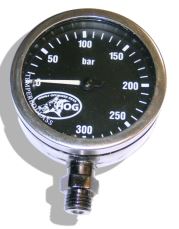 As
our Active Divers Association members venture into other
countries, they will invariably encounter a measuring
system unfamiliar to what we are accustomed. The metric
and bar measurement system is the most frequently used
system outside of the United States. Some basic
understanding of the metric and bar system can simplify
any confusion during the dive instructions.
As
our Active Divers Association members venture into other
countries, they will invariably encounter a measuring
system unfamiliar to what we are accustomed. The metric
and bar measurement system is the most frequently used
system outside of the United States. Some basic
understanding of the metric and bar system can simplify
any confusion during the dive instructions.
The conversion problem is usually not a major issue because most divers travel with their gauges or computers, which will continue to give the diver the information in the customary psi and feet measurements. Most dive computers do have the capability to convert the information from imperial and psi to meters and bar. The problem usually arises during the dive briefings, or if rental equipment is utilized.
![]()
 Diving the Ero Jacks
at John U. Lloyd Beach State Park was one of my favorite
dives yet. An Erojack is an artificial reef constructed
of concrete objects called dolos, that resemble a
child's jacks. My favorite dive was getting certified.
One of the reasons why it was one of my favorite dives
is because, that day I didn’t have to do any scuba
drills. All I had to do was enjoy the dive and watch the
animals interact with each other.
Diving the Ero Jacks
at John U. Lloyd Beach State Park was one of my favorite
dives yet. An Erojack is an artificial reef constructed
of concrete objects called dolos, that resemble a
child's jacks. My favorite dive was getting certified.
One of the reasons why it was one of my favorite dives
is because, that day I didn’t have to do any scuba
drills. All I had to do was enjoy the dive and watch the
animals interact with each other.
Even though I didn’t have to do any scuba drills that day I had to walk all the way to the spot where we were going to enter with all of the equipment on, which took about ten minutes or so. I didn’t mind the walk because one it was on the beach and I could walk along the water, and two I was excited for the dive which really took my mind off the walk. When we finally reached the spot we swam out on our backs for about another ten minutes and submerged.
I was nervous a little bit because this dive was the deepest I have ever gone (which up until now was only 30 feet), but once I corrected my buoyancy and stabilized my breathing, I continued the dive with no complications. Seeing how they created an artificial reef out of these ero jacks was quite amazing, because the sea creatures all worked together to bring it alive just like a community. I saw the usual reef fish in juvenile and in adult form such as angelfish, snapper, tangs, and triggerfish, along with a few nurse sharks and different types of rays. But finally the time came and we had to end the dive and ascend. As we made it back to the shoreline we had to walk all the way back which I totally forgot about while underwater. In the end the dive was spectacular and well worth the walk.
![]()
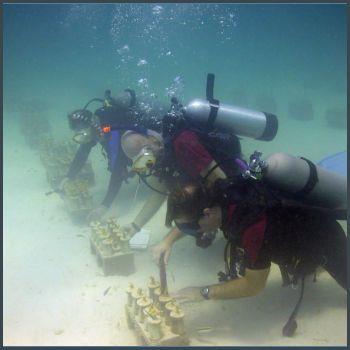 Coral
reefs are the literal foundation for the marine
environment we scuba divers enjoy so much. Those of us
who have been diving forty years or more remember when
the Florida Keys reefs were many times more beautiful
and populated with colorful corals than they are now.
Beginning in the late 1970s and early eighties, multiple
stressors—thermal, chemical, and biological—caused the
dominant reef-building corals in the Keys and Caribbean
to decline dramatically, leaving the remaining corals
scattered and less beautiful. However, thanks to the
efforts and ingenuity of people like Ken Nedimyer,
founder and president of the Coral Restoration
Foundation (“CRF”), the reefs we all love to dive are
making a comeback.
Coral
reefs are the literal foundation for the marine
environment we scuba divers enjoy so much. Those of us
who have been diving forty years or more remember when
the Florida Keys reefs were many times more beautiful
and populated with colorful corals than they are now.
Beginning in the late 1970s and early eighties, multiple
stressors—thermal, chemical, and biological—caused the
dominant reef-building corals in the Keys and Caribbean
to decline dramatically, leaving the remaining corals
scattered and less beautiful. However, thanks to the
efforts and ingenuity of people like Ken Nedimyer,
founder and president of the Coral Restoration
Foundation (“CRF”), the reefs we all love to dive are
making a comeback.
First, as we always remind everyone, MONITOR YOUR AIR! This, along with good dive planning, will avoid any such emergency. And remember, a good buddy is always close by. So give him the "out of air" signal, (see ADA hand signals) and begin the shared air procedure. If for some reason that is not a viable alternative, DON'T PANIC!
You may not be aware of the fact that modern regulators, will not, and cannot by design, suddenly stop supplying air even when your pressure gauge nears zero. At any given depth, as the pressure nears zero, inhale resistance will be noticeably greater. If a calm, rested diver begins the ascent at the first sign of increased resistance, it is possible to continue a slow breathing cycle all the way to the surface. Conversely, a panicked, air gulping, diver will doubtfully notice this subtle increase in breathing resistance. This diver at that point will be forced to make an emergency free ascent to the surface, a difficult and dangerous procedure. Remember to exhale all the way up.
Moral of the story: remain calm, even when it seems all is lost
![]()
On at least 4 occasions in 2015, ADA Safety Officers have canceled dives. Why? The are several reasons for this. Understanding all of the reasons will help our membership avoid confusion and disappointment.
- Mechanical problems- with boats or dive equipment such as compressors.
- Boat crew family emergencies- no one available to drive the boat.
- Limited u/w visibility- can make dives unpleasant and even dangerous.
- Large waves- making dives unpleasant or dangerous.
- Severe weather warnings- such as tornadoes.
- Boat sinkings- yes, this actually happened. Several years ago, American Dream was rammed and sank while tied to the dock. We now dive on American Dream II in Ft. Lauderdale.
So the moral of this story is ALWAYS CALL LON at 305-251-4975 FOR A WEATHER CHECK AND DIVE STATUS UPDATE. For afternoon dives, call between 9 AM and 10 a.m. and you will never be misinformed. This vital information needed to make a decision is not available before 9 a.m. because the dive boat operator will have not yet reported ocean conditions for the morning dive. If you call after 10 a.m. chances are no one from ADA will be available to take your call. Remember, we can't call you due to the large numbers of divers involved. So, 30 seconds of your time to make the call may save you hours of driving time and a lot of gas money.
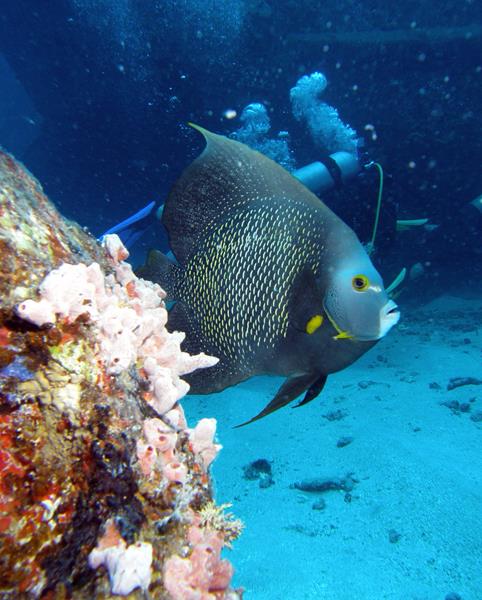
![]()
If so, please email or call us with your current information. you may send an email to: Dr. Dan Baeza, Membership Chair at dmbaeza@bellsouth.net. You can also call Dan at 954-260-8225 and leave a message with your new contact information.
Show your pride in the best dive club anywhere! Sizes small, medium, large, xlarge, xxlarge. Some tank tops available also. All shirts are $10 each. CALL LON AT 305-251-4975 AND PLACE YOUR ORDER TODAY!. Lon will deliver it to you on your next dive

BCD
Leaking?
--by
Dr. Dan Baeza
Often after a dive or two, you take your bouyancy control device (BCD) off, turn it upside-down, and drain what seems like a gallon of water. Is your BCD leaking? Naaahhh. It seems impossible that so much water.can enter your BCD unless there is a leak. However, the answer is simple and straightforward. Your BCD takes on water any time you open one of its dump valves. In the course of a dive, a typical diver may adjust the air in his BCD as many as 15 times. Each time you open a valve, a little water gets in. At the end of two dives, you can be carrying as much as a quart of water as unintended ballast.
The solution? Drain your BCD after each dive, and hold the dump valves open underwater only as long as necessary. You won't completely eliminate all the water that tends to accumulate during a dive, but you will go a long way toward removing your "excess baggage".
![]()
Want your newsletter delivered via snail-mail? Contact the webmaster and request a printed copy. Be sure to put "ADA Newsletter" in the subject.

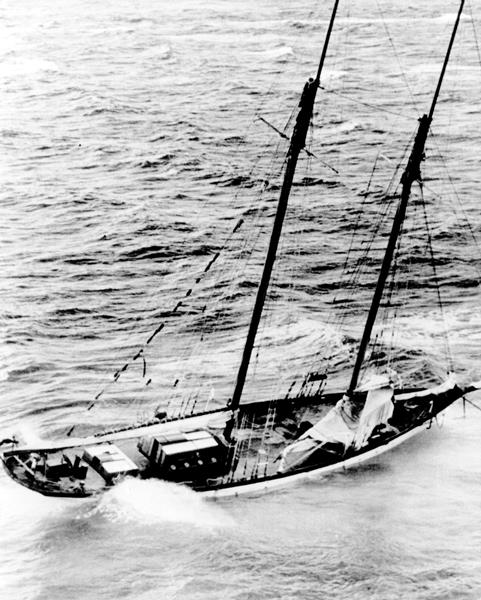 Just south
of the Lugano, on Long Reef, lies the Mandalay.
The steel-hulled schooner Mandalay was known
as the “Red Carpet Ship of the Windjammer
Just south
of the Lugano, on Long Reef, lies the Mandalay.
The steel-hulled schooner Mandalay was known
as the “Red Carpet Ship of the Windjammer  Fleet” and was
outfitted with a teak and mahogany deck. The Mandalay
was headed to Miami from the Bahamas on December 31,
1965 with 23 vacationers. The Captain miscalculated
the distance from Fowey Rock. They were off course by
20 miles. No one was hurt when she sank.
Fleet” and was
outfitted with a teak and mahogany deck. The Mandalay
was headed to Miami from the Bahamas on December 31,
1965 with 23 vacationers. The Captain miscalculated
the distance from Fowey Rock. They were off course by
20 miles. No one was hurt when she sank.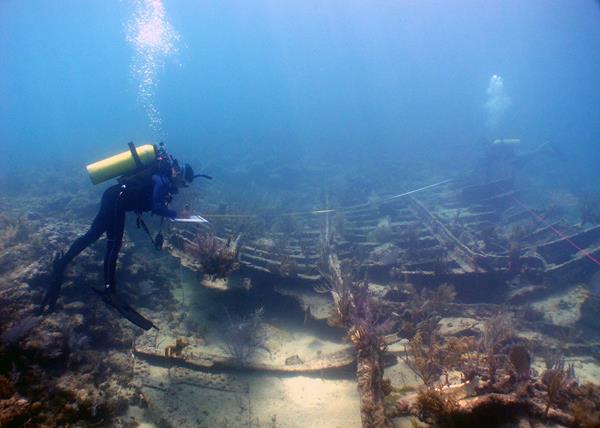


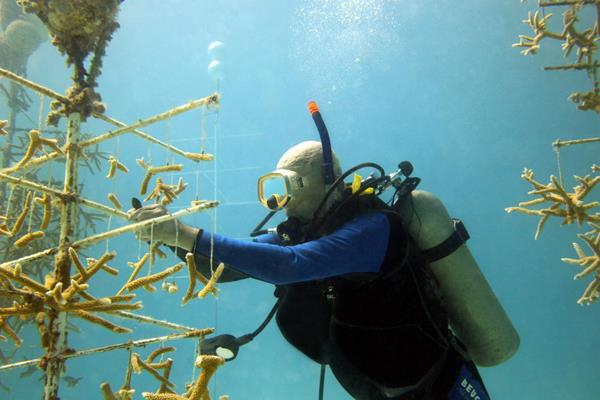 The ADA has been
diving with Ken and the CRF team since 2008, with one
or two educational sessions and coral outplanting dive
trips in each of the last several years. On such trips
we work in teams with CRF staff members, first to
harvest baby corals from the nursery and clean the
underwater “trees” the babies hang from while growing
to transplantable size. Those trees, which allow the
corals to hang in the current and enjoy fresh water
flowing around, have in recent years replaced the
earlier method CRF used of growing the nursery stock
on small concrete discs. After leaving the nursery, we
move to the reef and affix the transplants with epoxy
to hold them in place until they take root and stand
on their own. One-at-a-time, CRF staff and volunteers
outplanted more than 23,000 baby corals during 2015
alone. In the last few years CRF has started growing
and transplanting elkhorn coral and well as staghorn.
Each group of transplants is tagged with identifying
numbers and the growth of various sub-species is
carefully monitored and documented to help in
scientific research that helps CRF learn how to make
its program more effective and successful. Corals that
ADA members transplanted eight years ago are now
thriving and several feet tall.
The ADA has been
diving with Ken and the CRF team since 2008, with one
or two educational sessions and coral outplanting dive
trips in each of the last several years. On such trips
we work in teams with CRF staff members, first to
harvest baby corals from the nursery and clean the
underwater “trees” the babies hang from while growing
to transplantable size. Those trees, which allow the
corals to hang in the current and enjoy fresh water
flowing around, have in recent years replaced the
earlier method CRF used of growing the nursery stock
on small concrete discs. After leaving the nursery, we
move to the reef and affix the transplants with epoxy
to hold them in place until they take root and stand
on their own. One-at-a-time, CRF staff and volunteers
outplanted more than 23,000 baby corals during 2015
alone. In the last few years CRF has started growing
and transplanting elkhorn coral and well as staghorn.
Each group of transplants is tagged with identifying
numbers and the growth of various sub-species is
carefully monitored and documented to help in
scientific research that helps CRF learn how to make
its program more effective and successful. Corals that
ADA members transplanted eight years ago are now
thriving and several feet tall.